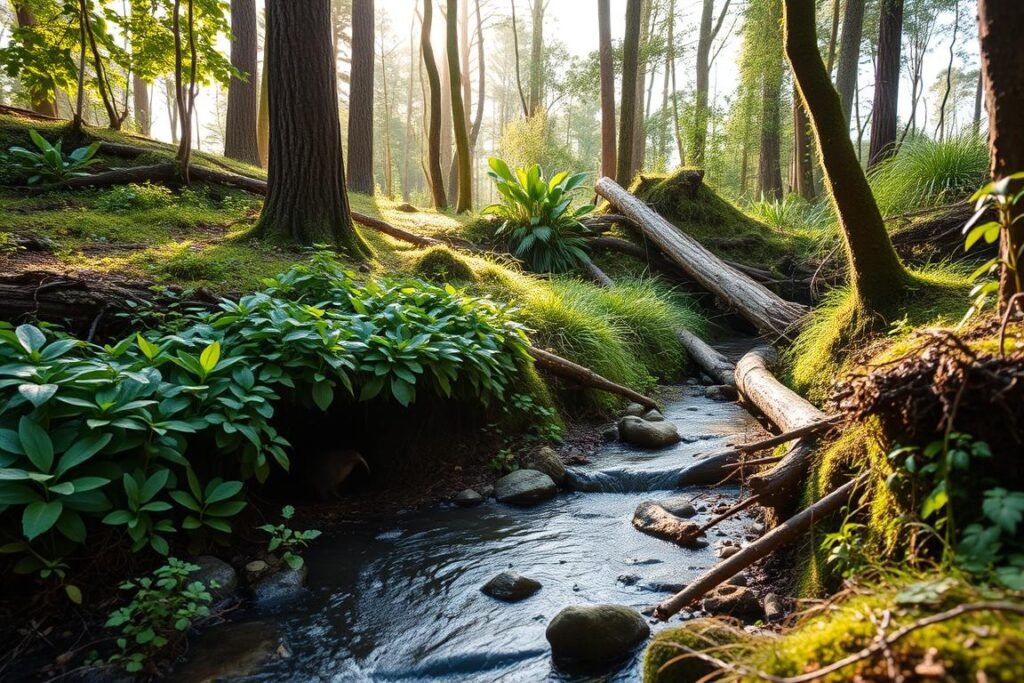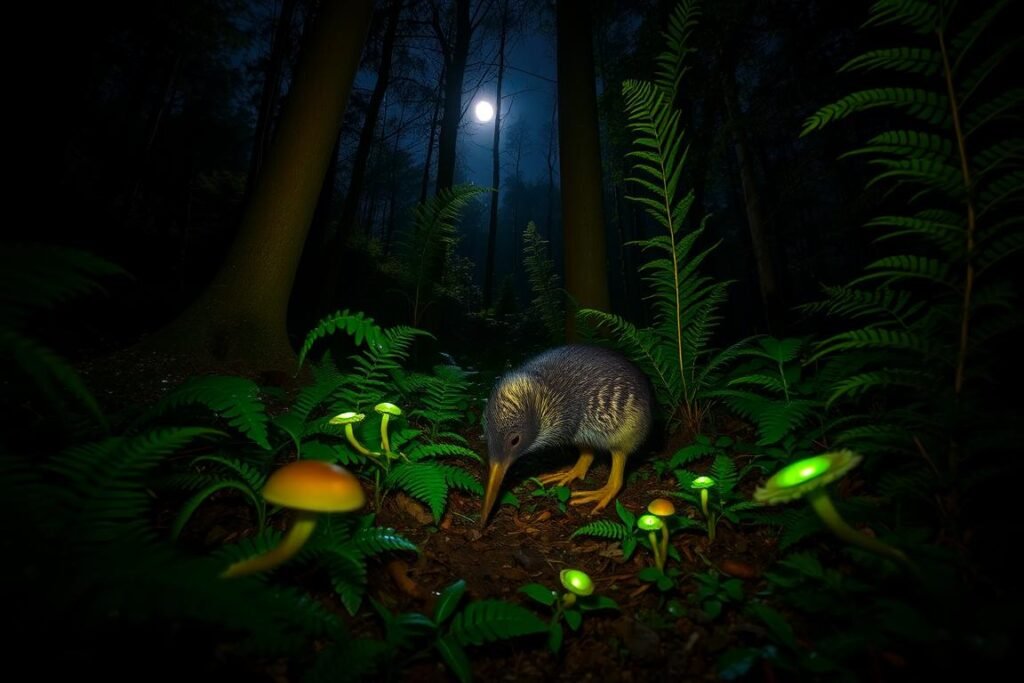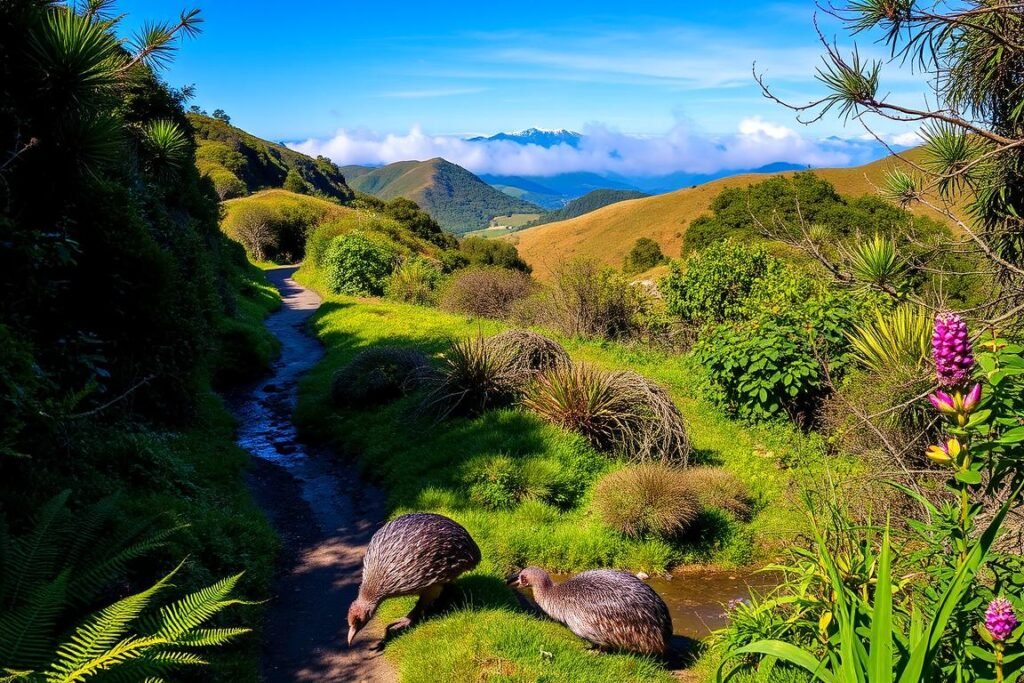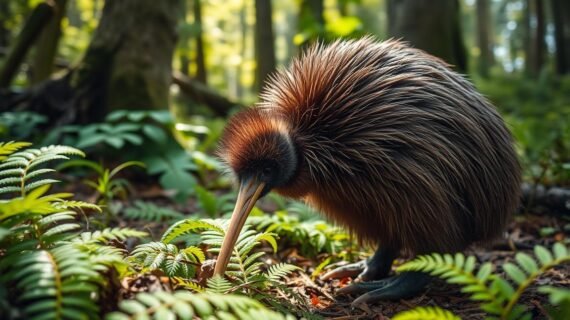Ever wondered about catching a glimpse of New Zealand’s iconic kiwi? As someone who loves nature and eco-tourism, I’ve always been drawn to these flightless birds. They’re special because of their unique traits, endangered status, and deep cultural importance. But what makes them so unique, and how can you see them?
In this guide, we’ll explore the kiwi bird’s mysteries. We’ll look at its unique features and where it lives. You’ll learn the best places to see kiwis. This is perfect for anyone interested in New Zealand’s wildlife, nature, or just curious about kiwis.
Key Takeaways
- Discover the unique characteristics and behaviors of the elusive New Zealand kiwi
- Explore the native habitats of this iconic flightless bird, from ancient forests to rugged coastlines
- Learn about the conservation efforts to protect the endangered kiwi population
- Uncover the cultural significance of the kiwi in Maori traditions
- Find the best spots for kiwi watching in New Zealand’s top wildlife reserves and national parks
Unraveling the Mysteries of the New Zealand Kiwi
The kiwi is New Zealand’s iconic bird, loved by all. These birds are active at night and have special features. Their unique beaks and adaptations to the dark make them fascinating.
The Nocturnal Icon of New Zealand's Wilderness
Kiwis are most active at night. This helps them live in New Zealand’s dense forests and rugged lands. They use their keen senses to find food and move around in the dark.
Understanding the Unique Characteristics of This Flightless Bird
The kiwi’s beak is long and sensitive. It helps them search for food in the soil and leaf litter. Their strong legs also help them move through dense areas.
Kiwis lay the largest eggs compared to their body size. These eggs can be very heavy. This shows how well kiwis have adapted to their environment.
“The kiwi is a true icon of New Zealand’s wilderness, a symbol of the country’s unique and diverse wildlife.”
Exploring the Native Habitat of the Kiwi
New Zealand’s kiwi birds are truly remarkable. Their native habitat shows off the country’s diverse landscapes. From lush forests to rugged coastlines, these birds thrive in different environments.
Ancient Forests: Kiwi's Woodland Sanctuary
Step into New Zealand’s ancient forests to find the kiwi’s home. These forests offer shelter, food, and solitude for these birds. Towering kauri trees, ferns, and mosses create a mysterious atmosphere.
In these forests, kiwis hunt for insects, worms, and small prey. They use their long beaks to search the soil and leaf litter. The dense vegetation gives them security, allowing them to move safely.
Rugged Coastlines: Kiwi's Coastal Outposts
Kiwis also live in New Zealand’s rugged coastal regions. Along the cliffs and rocky shores, they find a special habitat. This environment meets their unique needs.
Coastal kiwis feed on abundant invertebrates along the shoreline and in rock crevices. Their strong legs and resilient nature help them navigate the terrain. They find shelter in the coastline’s cracks and crevices.
The kiwi’s habitat, whether in forests or along coastlines, showcases New Zealand’s natural wonders. By preserving these environments, we help this iconic bird thrive.
| Habitat Type | Key Features | Kiwi Adaptations |
|---|---|---|
| Ancient Forests |
|
|
| Rugged Coastlines |
|
|
“The kiwi’s native habitat is a true reflection of New Zealand’s diverse and captivating natural landscapes, from the ancient forests to the rugged coastlines.”
New Zealand Kiwi: An Endangered Species
The kiwi, a beloved national icon of New Zealand, is facing a troubling reality – it is now classified as an endangered species. This flightless bird, so unique and integral to the country’s natural heritage, is under threat from a range of challenges that put its very survival at risk.
Habitat loss is a major threat to the kiwi. Human development is encroaching on their natural habitats, from ancient forests to rugged coastlines. Deforestation, urbanization, and the introduction of predatory species have all taken a toll on kiwi populations, leaving them vulnerable and struggling to maintain their numbers.
The kiwi also faces threats from predators such as stoats, possums, and dogs. These invasive species, brought to New Zealand by human activity, prey on the kiwi’s eggs and chicks, decimating the population. Efforts to control and eradicate these predators have been ongoing, but the challenge remains significant.
Despite these daunting challenges, there is hope for the kiwi’s future. Dedicated conservation efforts, spearheaded by the government, local communities, and environmental organizations, are working tirelessly to protect and restore the kiwi’s habitats, and to safeguard these remarkable birds from the threats they face.
From predator control programs to habitat restoration initiatives, the conservation of the kiwi is a testament to New Zealand’s commitment to preserving its unique and irreplaceable natural heritage. As we continue to explore the wonders of the kiwi and its native habitats, it is crucial that we support these crucial conservation efforts to ensure the kiwi’s survival for generations to come.
“The kiwi is a symbol of New Zealand’s natural beauty and biodiversity. It is our responsibility to protect this iconic species and ensure its continued presence in our landscapes for years to come.”
Conservation Efforts: Protecting New Zealand's National Treasure

New Zealand’s government and local communities are working hard to protect the kiwi. Their efforts show a strong commitment to saving this iconic bird. It’s a big step in keeping New Zealand’s natural beauty alive.
The Role of Government and Local Communities
The New Zealand government has set up strong policies to protect the kiwi. They’ve created safe habitats and funded conservation projects. This shows they really understand how important the kiwi is.
Local communities are also playing a big role. They volunteer their time and resources to help save the kiwi. Their efforts are crucial in keeping this bird alive.
Eco-tourism and Sustainable Tourism Initiatives
Eco-tourism and sustainable tourism are helping to save the kiwi. These programs offer safe ways to see wildlife. They help raise awareness and support conservation.
Travelers can now explore the kiwi’s home while helping protect it. This is a win-win situation for both nature lovers and the kiwi.
| Conservation Initiatives | Impact |
|---|---|
| Kiwi Sanctuaries | Establish protected habitats for kiwi populations to thrive |
| Predator Control Programs | Reduce the threat of invasive species that prey on kiwi nests and chicks |
| Community-based Monitoring | Engage local residents in tracking and reporting kiwi sightings |
| Eco-tourism Experiences | Raise awareness and generate funds for kiwi conservation efforts |
The government, local communities, and eco-tourism are all working together. This means the kiwi’s future in New Zealand is looking good. By protecting this national treasure, we ensure future generations can still enjoy the kiwi’s unique charm.
The Cultural Significance of the Kiwi in Maori Traditions
Exploring Maori culture, I find the kiwi’s importance striking. This flightless bird is a symbol of New Zealand. It holds a special place in Maori traditions, stories, and life.
Maori culture values the natural world deeply. The kiwi represents this bond. It symbolizes strength, endurance, and the need to protect the environment.
“The kiwi is not merely a bird to the Maori; it is a living embodiment of their ancestral ties to the land and their responsibility as guardians of the natural world.”
In Maori art, the kiwi is a common theme. It decorates carvings, weavings, and more. The kiwi’s feathers are used in ceremonial clothes, linking the wearer to its spirit.
The Maori understand the kiwi’s habits and habitat well. This knowledge has helped them appreciate the bird. It also guides efforts to save this national treasure.
Learning about Maori culture, I’m amazed by their bond with the kiwi. This bird is more than just a creature. It represents the Maori’s connection to the land and their duty to protect it.
Best Spots for Kiwi Watching in New Zealand

If you want to see a kiwi in the wild, New Zealand has great spots. You can find wildlife reserves and national parks with amazing kiwi-watching opportunities. Let’s look at the top places to see these special birds.
Top Wildlife Reserves and National Parks
The Zealandia Eco-sanctuary in Wellington is perfect for kiwi watching. It’s a wildlife reserve with many kiwis. You can go on night tours to see them.
Tongariro National Park in the North Island is another great spot. Its wild landscapes and forests are great for spotting kiwis. You can join guided walks or go on your own to see them.
| Wildlife Reserve | Location | Kiwi Sighting Opportunities |
|---|---|---|
| Zealandia Eco-sanctuary | Wellington | Guided night tours to observe kiwis in their natural habitat |
| Tongariro National Park | Central North Island | Guided walks and self-guided tours to spot kiwis in the rugged landscapes |
| Okarito Kiwi Sanctuary | West Coast of the South Island | Guided walks and night tours to see the elusive Okarito brown kiwi |
The Okarito Kiwi Sanctuary on the South Island’s West Coast is special. It offers guided walks and night tours. Here, you can see the rare Okarito brown kiwi.
Choosing Zealandia, Tongariro, or Okarito for kiwi watching is unforgettable. Each place offers a unique chance to see these amazing birds in New Zealand’s beautiful nature.
Preparing for a Kiwi Encounter: Tips and Tricks
Seeing a New Zealand kiwi in its natural home is a rare chance. It needs careful planning and knowing how to watch wildlife right. I’ll give you tips for a great and respectful kiwi watching trip.
Ethical Wildlife Viewing Practices
When you meet a kiwi, it’s important to do it right. Here are some tips to help you:
- Keep a safe distance from the kiwi. This helps avoid stressing it out.
- Move quietly and don’t make too much noise. Kiwis get scared easily.
- Don’t use bright lights or flashlights. They can mess up the kiwi’s night and eyes.
- Stick to the paths and trails. Going off-road can hurt the environment.
- Listen to guides or rangers. They know how to protect kiwis and their homes.
By following these tips, your kiwi encounter will be unforgettable. It will also help protect these amazing birds and their homes.
Watching kiwis the right way is a big responsibility. It’s a chance we have to keep these special birds safe for others to see in the future.
Unique Kiwi Tours and Guided Experiences

For those looking for a deeper kiwi experience, New Zealand offers special tours. These tours let you see these amazing birds up close. You can go on night walks or get a behind-the-scenes look, learning more about the iconic New Zealand kiwi.
One great option is the nocturnal kiwi tour. Here, you can see these rare birds at night. Guides use special lights to show you the kiwi’s natural behavior.
Another cool experience is the kiwi conservation tour. You get to visit places where they work to save kiwi birds. You might even help with tasks like weighing them.
- Nocturnal kiwi walks and night tours
- Kiwi conservation and rehabilitation center visits
- Behind-the-scenes encounters with kiwi experts
- Guided hikes through kiwi habitats
These unique kiwi tours and guided experiences are a great way to connect with New Zealand’s national symbol. You’ll learn a lot about the efforts to save this special bird.
“The kiwi tour was the highlight of our New Zealand trip. Seeing these elusive birds in their natural habitat was truly a once-in-a-lifetime experience.”
Creating Unforgettable Memories with New Zealand's Kiwi
Seeing a kiwi in its natural home is a breathtaking experience. It leaves a lasting mark on those who visit New Zealand. This flightless bird, a national symbol, captivates and inspires those who see it.
Imagine watching a kiwi search for food quietly. Its long beak probes the ground for tasty treats. Seeing this unique bird is a moment you’ll never forget.
Meeting a kiwi can also deepen your connection to New Zealand’s nature. Standing near this bird, you’ll appreciate the country’s ecosystems more. You’ll also understand the need to protect these endangered birds.
“Seeing a kiwi in the wild was one of the most incredible experiences of my life. It’s a moment I’ll never forget, and it inspired me to learn more about these fascinating creatures and how I can help support their preservation.”
Whether you’re hiking in forests, exploring coasts, or visiting wildlife reserves, seeing a kiwi is a privilege. These kiwi encounters make unforgettable memories that last long after your trip.
So, when planning your trip to New Zealand, make sure to include kiwi-watching. With patience and the help of local guides, you can make your own unforgettable memories with New Zealand’s beloved kiwi.
| Kiwi Encounter Highlights | What to Expect |
|---|---|
| Nighttime Kiwi Spotting | Witness the kiwi’s unique nocturnal behavior as it forages for food under the cover of darkness. |
| Guided Kiwi Walks | Join experienced local guides who will lead you through the best kiwi habitats and share their knowledge about these fascinating birds. |
| Kiwi Rehabilitation Centers | Visit specialized facilities that are dedicated to the rehabilitation and conservation of injured or orphaned kiwis, providing a unique educational experience. |
Conclusion
As we wrap up our exploration of the New Zealand kiwi, I hope you now appreciate this amazing bird more. We’ve covered its unique traits, conservation work, and top places to see kiwis. This guide has everything you need for an unforgettable wildlife adventure in New Zealand.
If you love nature, are an eco-tourist, or just curious about kiwis, this article has helped you. You now know how to make the most of your kiwi experience. By learning about kiwi’s cultural value and how to watch wildlife responsibly, your visit will be both meaningful and kind to the environment.
When you start exploring the kiwi’s home, from old forests to rocky shores, be amazed and careful. Our shared efforts can help protect the kiwi. This way, this special bird will stay a key part of New Zealand’s nature for many years.
FAQ
What makes the New Zealand kiwi so unique?
The New Zealand kiwi is a remarkable bird. It has a unique beak and lives at night. It can’t fly but has captured the world’s heart.
Where can I find the kiwi’s native habitat in New Zealand?
Kiwi habitats in New Zealand are diverse. You can find them in ancient forests and coastal areas. They live in many places across the country.
Is the kiwi an endangered species?
Yes, the kiwi is endangered. It faces many threats. But, many groups are working hard to save these birds.
How can I learn about the cultural significance of the kiwi in Maori traditions?
The kiwi is very important to the Maori people. Learning about their traditions and beliefs can help you appreciate the kiwi’s cultural value.
Where can I find the best spots for kiwi watching in New Zealand?
You can see kiwis in many wildlife reserves and national parks. These places are known for good kiwi sightings.
What should I consider when preparing for a kiwi encounter?
To see a kiwi, you need to prepare carefully. Know how to watch wildlife without disturbing them. This way, you can have a great kiwi watching experience.
Are there any unique kiwi tours or guided experiences available in New Zealand?
Yes, there are special tours to see kiwis. These tours help you learn more about these amazing birds. They make your kiwi encounter even better.






